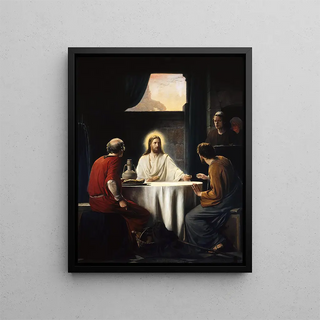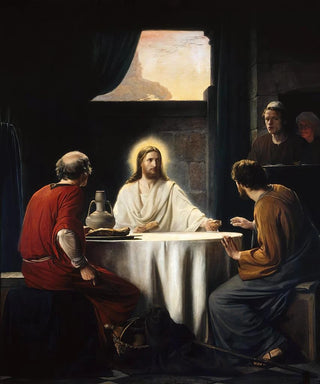Emmaus Supper Painting - Carl Bloch | Art print


View from behind

Frame (optional)
Emmaus Supper - Carl Bloch – Captivating Introduction
At the heart of art history, certain works stand out for their ability to capture the very essence of humanity. "Emmaus Supper - Carl Bloch" is one of these masterful pieces that invites viewers to a profound reflection on faith, revelation, and communion. The scene, imbued with mystery and sacredness, depicts a key moment in Christian tradition: the disciples' encounter with the resurrected Christ. This painting, both vibrant and moving, transports the viewer into an emotionally charged atmosphere, where every detail seems to whisper a story to those who take the time to immerse themselves in it.
Style and uniqueness of the work
Carl Bloch's work is characterized by a style that skillfully combines realism and spirituality. In "Emmaus Supper," light plays a leading role, illuminating the disciples' faces with an intensity that highlights their astonishment and wonder at the divine revelation. Rich colors and delicate textures create a depth that brings the scene to life. The expressions of the characters are finely rendered, demonstrating an exceptional talent for capturing the nuances of human emotions. Bloch manages to transcend the simple narrative painting to offer an immersive experience, where the viewer is invited to feel the tension between doubt and faith, between the invisible and the visible.
The artist and his influence
Carl Bloch, a Danish painter of the 19th century, is often regarded as one of the masters of religious realism. His training in Europe, notably at the Royal Danish Academy of Fine Arts in Copenhagen, shaped his artistic approach, allowing him to develop a unique style that combines technical precision with spiritual depth. Bloch established himself in the artistic landscape of his time, influencing many artists with his ability to evoke biblical stories with dramatic intensity. His works, often commissioned for churches and religious institutions, testify to a deep commitment to spirituality and visual storytelling. Through "Emmaus Supper," he manages to establish an timeless dialogue between art and faith, uniting generations around a universal message.
A decoration

Matte finish

View from behind

Frame (optional)
Emmaus Supper - Carl Bloch – Captivating Introduction
At the heart of art history, certain works stand out for their ability to capture the very essence of humanity. "Emmaus Supper - Carl Bloch" is one of these masterful pieces that invites viewers to a profound reflection on faith, revelation, and communion. The scene, imbued with mystery and sacredness, depicts a key moment in Christian tradition: the disciples' encounter with the resurrected Christ. This painting, both vibrant and moving, transports the viewer into an emotionally charged atmosphere, where every detail seems to whisper a story to those who take the time to immerse themselves in it.
Style and uniqueness of the work
Carl Bloch's work is characterized by a style that skillfully combines realism and spirituality. In "Emmaus Supper," light plays a leading role, illuminating the disciples' faces with an intensity that highlights their astonishment and wonder at the divine revelation. Rich colors and delicate textures create a depth that brings the scene to life. The expressions of the characters are finely rendered, demonstrating an exceptional talent for capturing the nuances of human emotions. Bloch manages to transcend the simple narrative painting to offer an immersive experience, where the viewer is invited to feel the tension between doubt and faith, between the invisible and the visible.
The artist and his influence
Carl Bloch, a Danish painter of the 19th century, is often regarded as one of the masters of religious realism. His training in Europe, notably at the Royal Danish Academy of Fine Arts in Copenhagen, shaped his artistic approach, allowing him to develop a unique style that combines technical precision with spiritual depth. Bloch established himself in the artistic landscape of his time, influencing many artists with his ability to evoke biblical stories with dramatic intensity. His works, often commissioned for churches and religious institutions, testify to a deep commitment to spirituality and visual storytelling. Through "Emmaus Supper," he manages to establish an timeless dialogue between art and faith, uniting generations around a universal message.
A decoration
12,34 €






